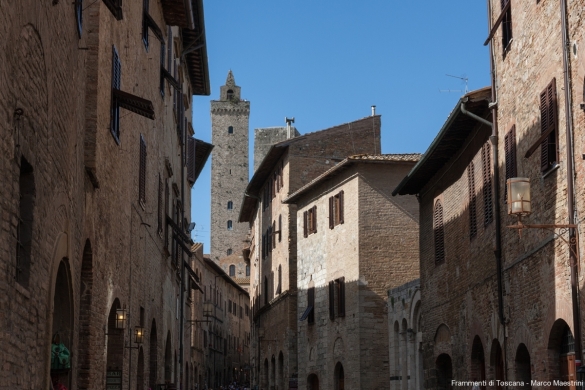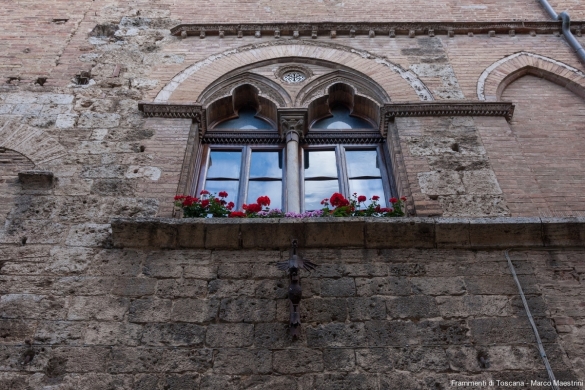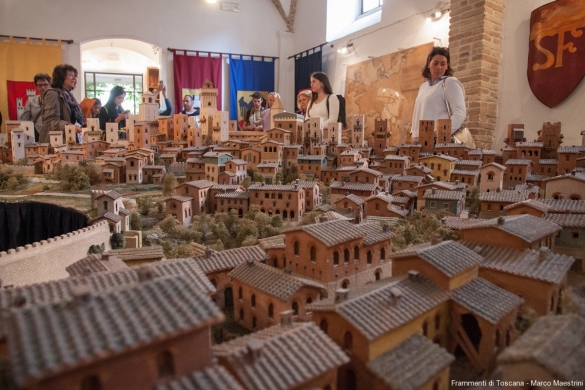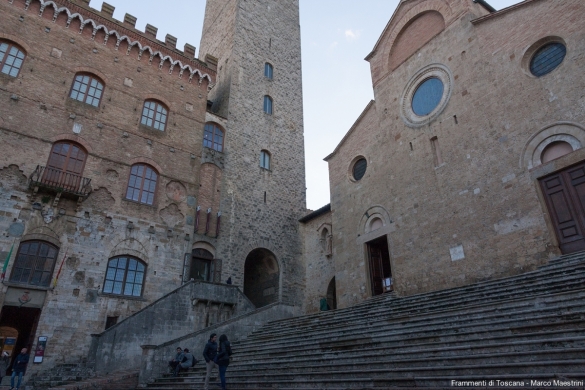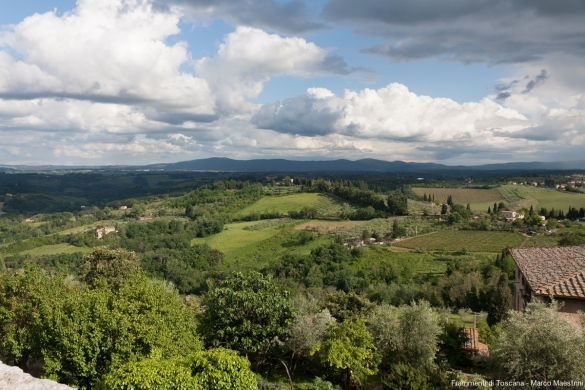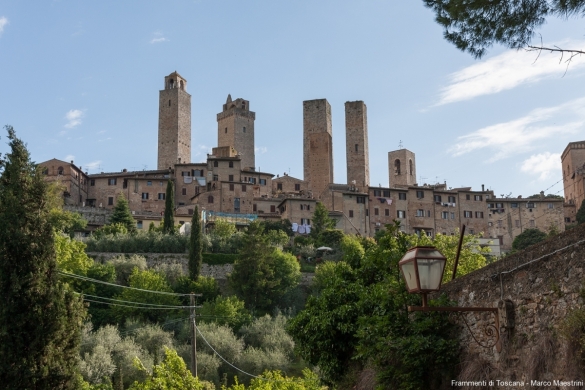San Gimignano is renown all over the world as one of the most beautiful towns in Tuscany, and has been defined as a medieval Manhattan for the towers that dominate its skyline. The town is visited by over 3 million visitors every year being thus often crowded, especially during the Summertime. One might say that in certain moments of the year San Gimignano is literally bursting with people, however even during the high season there are some unconventional paths to follow for a more unusual visit. We were lucky to be among the participants of a guided tour organized by a local association (the CCN – Natural Commercial Centre – of San Gimignano) that allowed us to get a more in-depth knowledge of the town, including less common corners and locations. Here are 10 must dos to experience the immortal beauty of San Gimignano
1 – KNOWING… the rise and fall of a medieval jewel: the town is one of the best preserved medieval centres in Europe and owes this amazing conservation to its history. San Gimignano prospered thanks to the Francigena road, the route that in the Middle Ages connected Canterbury to Rome running across France (hence the name Francigena) and Italy. San Gimignano represented one of the stages along the road, where pilgrims and merchants could stay for the night. The fact of being one of the stops of the route fostered the development of handicraft and trade activities, and the town bloomed with a spectacular economic, artistic and urban development.
However the plague that devastated the whole European continent in 1348 decimated the population of San Gimignano as well and, as a consequence, the town started declining. In fact, the Via Francigena was soon abandoned as new and quickest roads were eventually opened during the Renaissance and then the Modern times. San Gimignano got isolated and poor, but this disgraceful destiny has been our fortune, since the lack of economic means made it impossible for the local governors and families to invest in urban planning and renovations. That’s why we can still admire the historical centre as if we were right in the Middle Ages. Although not all the towers have survived (most of them were cut off or destroyed due to contrasts between the families of the town) the medieval asset is still almost intact.
2. FOLLOWING THE TRACKS OF PILGRIMS along the Francigena road: the gate Porta San Giovanni is the main entrance to the walled town and the street of the same name, that departs from the gate towards the centre, corresponds to the medieval Francigena road. The street is dotted with bars, souvenir shops, restaurants and very crowded, however although you can’t escape the crow, of course you can act different than the others do. Carefully observe what surrounds you…Immediately after the gate, on your right the remains of the church dedicated to St. Francis are well visible with the façade featured by horizontal black stripes, that recall the Pisan gothic style. This is due to the fact that in the Middle Ages the church was a shelter for the pilgrims and travellers along the Francigena road and eventually became a convent. Follow the street that starts to gently climb: you can now see the towers that get nearer and nearer.
Particolare dell’ex Convento di Santa Caterina
3. HOPPING THE TIME MACHINE BACK TO “San Gimignano 1300”: once you are at the end of San Giovanni street (see point 2) we suggest that you don’t follow the crowd towards the main squares of the town: turn left instead and follow the indications for the “San Gimignano 1300” Museum. Here the asset of the town as it was in 1300 has been perfectly recreated in ceramic, with every single detail. You will see all the existing towers at those times (as you read under point 1, most of them collapsed or were destroyed with the passing of time). A journey back in time, possible thanks to the passion and patience of two artists with artists’ names – Michelangelo e Raffaello Rubino – who have donated their work to the town and its visitors. Open daily from 10 a.m to 7 p.m., for further info visit the website http://www.sangimignano1300.com/eng/index_eng.html
Museum San Gimignano 1300
4. CLIMBING the “Torre Grossa” tower: of course everyone in San Gimignano wishes to admire its towers! When the town was mighty and flourishing, there were over 72 towers, built up by the rich families as a symbol of their magnificence and power. Now only 13 remain, although others still exist but since they’ve been cut off and incorporated in lower buildings, aren’t clearly visible. The survived towers are admirable from the central squares (Piazza Duomo, Piazza delle Erbe and Piazza della Cisterna). You can get there in a more unconventional way: on your way out of the Museum San Gmignano 1300, continue along the road (Via Costarella), pass under one of the towers and you’ll be right on the staircase to access the Cathedral. You can visit the Cathedral, the Town Hall (rich in work of arts) and you also climb the Torre Grossa, the tower next to the Town Hall, for another medieval experience.
Up there, the view on the Tuscan landscape of the surroundings till the Apuan Alps is simply astonishing. With a ticket, valid for two days, you can have access to several museums of the town, including the tower. More information here! Now you can visit the second central square, Piazza della Cisterna, named after the well standing at its centre and used in the past for markets, tournaments and fairs. Both squares (Piazza Duomo and Piazza della Cisterna) are so popular and beautiful that the concentration of visitors here is really, really high. For a more relaxing and romantic view, try to plan your visit in the low season (autumn and winter) or – if inevitably you’ll be there in spring and summer – pay your visit at sunset.
Piazza del Duomo
5. DISCOVERING the ancient walls: the town was fortified and protected by two circles of walls: the first was built before the year 1000. The second was added in the 13th century, when San Gimignano was growing rich and potent. The walk along its perimeter is indicated by specific signs and can be started in different points of the town. You will walk away from the big crowd through alleys and small staircases, encounter the several gates of entrance to the city and enjoy mesmerizing views of the surrounding countryside.
Vista dalla terrazza di Via degli Innocenti
6. ESCAPING THE CROWD heading to the Medieval Founts: A visit to the Medieval Founts implies some exercise as the path is very steep, yet worthwhile! It is not difficult to get there from the centre: once in Piazza Cisterna, that with the well, follow the street called Via del Castello right behind the well, and Via Santo Stefano: the street starts to descent along gardens and vegetable gardens, and the towers peep out from behind the trees, until you get to the fascinating Porta alle Fonti, namely the Gate of Fountains. The last metres along the steep descent will lead you right to destination: the Medieval Fountains stand on your right with their stone arches made on different styles: those in the centre date back to the XII century, those on the right to the XIII century and the Romanesque, and those on the left to the XIV century and are Gothic. Time seems to have stood still in this corner of the town that is quiet and never too crowded.
7. CAPTURING THE PERFECT PICTURE to the towers: we write this point at the risk of stating the obvious, as whoever comes to San Gimignano wishes to go home with a picture of its unforgettable skyline. Well, finding the perfect place for the shot is less obvious and we give you a hint: on your way back from the Medieval Fountains, pass through Porta alle Fonti and take the first track on your right (if you are descending to the fountains, just before the gate take the track on your left): now turn back and…click! And you have another good reason to visit the Fountains.
8. ENJOYING great food and cosy location at the restaurant Locanda di Sant’Agostino: San Gimignano counts many good restaurants, you have plenty of places for a nice and typical meal here. As for us, we fell in love with the Locanda di Sant’Agostino in Sant’Agostino square, for several reasons: the first one is the quiet and relaxed location, away from the crowded centre. In Spring, Summer and early Autumn you can sit outside and enjoy the view on the square, its antique well and the Sant’Agostino church, while the interior is cosy, colourful and vintage in style. Other reason are the big bruschetta they make, the mouth-watering desserts (a special mention to the Panna Cotta with saffron and the Crème Brulée with ricotta cheese and cinnamon) and the use of local products and ingredients. The last reason is the adorable owner, Genziana, a gentle, smiley and friendly lady that makes everyone feel welcome.
9. BRINGING WITH YOU a little gold of San Gimignano, SAFFRON: in the Middle Ages San Gimignano came into contact with the Maritime Republic of Pisa, on the Tuscan cost. This encounter brought to the town not only an influence on the architecture (the Pisan Gothic style is still visible as we mentioned in point n.2), but also a spice coming from Asia, with which Pisa traded: saffron. In San Gimignano saffron found a perfect place to be cultivated, thanks to the peculiar soil of the area, and many families started to export themselves the product, making huge profits. The product was awarded the EU Denomination of Origin certificate, and can be purchased in the stores while you’re around the town. Just make sure to avoid powder and buy only stigmas, so to be 100% sure of its quality and purity.
10. LIVING THE MIDDLE AGES at the medieval festival “Ferie delle Messi” in Summer and ENJOYING LIGHTS and SHADOWS at the “Lumiere” Festival in Winter: Last but not least, two of the most evocative events the town offers in Summer and Winter. The medieval festival “Ferie delle Messi” in June celebrates Summer and the wheat harvest season, with many characters in medieval costumes, old taverns and games, in a perfect medieval setting. In the first weekend of December, the darkest time of the year when shadows reign over alleys and squares, the Festival “Lumière” enlightens the historic centre with its light artworks with the use of innovative digital technologies (in 2016, on December, Saturday 3rd and Sunday 4th)
Disclaimer: activities and brands described in the post reflect our personal and transparent opinions. Under no circumstance we are rewarded for our reviews.

